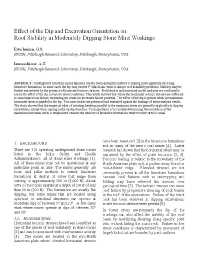Mining Publication: Effect of the Dip and Excavation Orientation on Roof Stability in Moderately Dipping Stone Mine Workings
Original creation date: January 2005
Underground limestone mines typically use the room-and-pillar method of mining in the generally flat-lying limestone formations. In some cases, the dip may exceed 5 deg, which can result in unique roof instability problems. Stability may be further exacerbated by the presence of horizontal tectonic stresses. Field studies and numerical model analyses are combined to assess the effect of the dip in various stress conditions. The results showed that where the horizontal tectonic stresses are sufficient to cause intact rock failure, increasing dip results in increased failure potential. The effect of the dip is greater when the maximum horizontal stress is parallel to the dip. Two case studies are presented and evaluated against the findings of stress analysis results. The study showed that the empirical rules of orienting headings parallel to the maximum stress are generally applicable to dipping excavations, except when mining in the up-dip direction. The importance of accurately determining the orientation of the maximum horizontal stress is emphasized because the window of favorable orientations relative to the stress is small.
Authors: GS Esterhuizen, AT Iannacchione
Conference Paper - January 2005
NIOSHTIC2 Number: 20028123
Proceedings of the 40th U.S. Rock Mechanics Symposium, Anchorage, AK, June 25-29, 2005. Alexandria, VA: American Rock Mechanics Association, 2005 Jun; :1-8
See Also
- Controlling Roof Beam Failures From High Horizontal Stresses in Underground Stone Mines
- Field Observations and Numerical Studies of Horizontal Stress Effects on Roof Stability in U.S. Limestone Mines
- Field Observations and Numerical Studies of Horizontal Stress Effects on Roof Stability in U.S. Limestone Mines
- Investigation of Pillar-Roof Contact Failure in Northern Appalachian Stone Mine Workings
- Pillar and Roof Span Design Guidelines for Underground Stone Mines
- Pillar Stability Issues Based on a Survey of Pillar Performance in Underground Limestone Mines
- Pillar Strength and Design Methodology for Stone Mines
- Propagation of UHF Radio Waves in Limestone Room and Pillar Mines
- Roof Span Design for Underground Stone Mines
- Roof Stability Issues in Underground Limestone Mines in the United States
- Page last reviewed: 9/21/2012
- Page last updated: 9/21/2012
- Content source: National Institute for Occupational Safety and Health, Mining Program


 ShareCompartir
ShareCompartir
